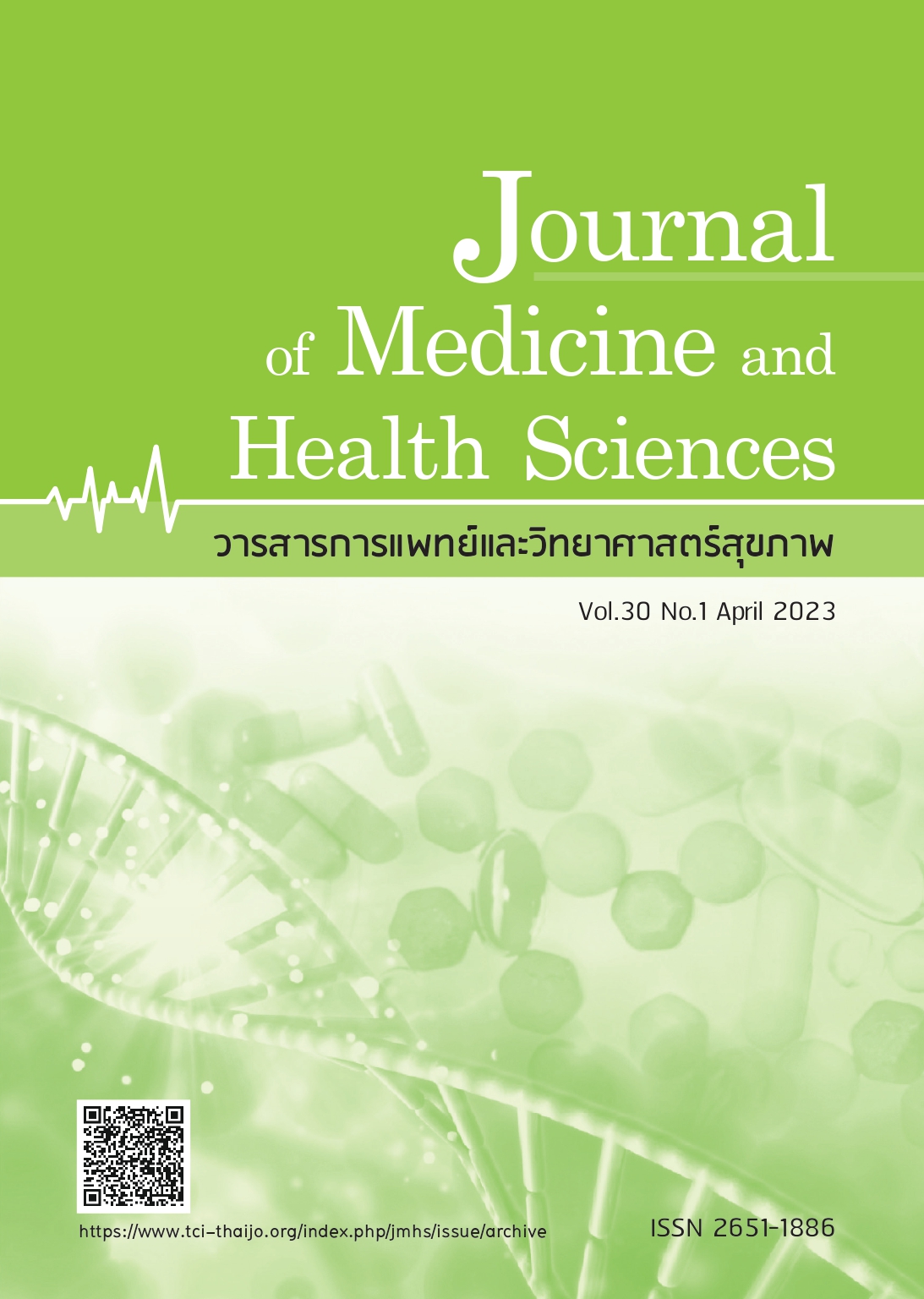Comparision outcome of sublingual and vaginal misoprostol for induction of labour at postterm in Samutsakhon hospital
Keywords:
sublingual misoprostol, vaginal misoprostol, induction of labour, postterm pregnancyAbstract
Induction of labor at postterm is the most common obstetric practice. Traditional oral and vaginal misoprostol are effective induction methods, but there is a delicate balance between successful rate, maternal and fetal safety, as well as convenience and savings. This ramdomized controlled trial method aims to compare the efficacy of vaginally administered and sublingual misoprostol for outcomes of induction delivery interval, maternal and fetal outcomes. Sixty-four pregnant women at postterm who fulfilled the inclusion criteria were equally randomized into the two groups to receive misoprostol 25 mcg sublingually or 25 mcg vaginally. The statistics were analyzed using a Chi-square test and an independent t-test. The results found the following: there were no statistical differences in the age, hieght, weight, body mass index number of pregnancies, parity, abortion, gestational age, Bishop score and birth weight in both groups. The mean time from the first dose to achievement of bishop score 7 or active phase was significantly shorter in the sublingual group than the vaginal group (8.33 ± 4.27 vs 10.49 ± 2.98, p = 0.022). The number of doses to achieve active phase the sublingual group was mostly 2 and vaginal group mostly 3 (p = 0.041). Also total number of successful vaginal delivery at 10-16 hour and were more in the sublingual group (61.54% vs 29.63% than the vaginal group, p = 0.028). There were no statistical differences of both groups in induction delivery interval, oxytocin augmentation, total number of successful vaginal delivery, delivery methods, adverse maternal and neonatal outcomes. In conclusion, sublingual misoprostol 25 mcg every 4 hour and a maximum of 4 times is effective for induction of labour at postterm.
References
Phongsatha S. Induction of labor in
Thongsong T, (editor), Obstetrics, 5th
edition. Chiang Mai: Department of
obstetrics and gynecology, faculty of
medicine, Chiang Mai university; 2012.
WHO. WHO recommendations: induction
of labour at or beyond term. Geneva:
World Health Organization; 2018. Licence:
CC BY-NC-SA 3.0 IGO.
Leduc D, Biringer A, Lee L, et al. Clinical
practice obstetrics special induction of
labour. J Obstet Gynaecol Can 2013;35:
-57.
Phetyim S, Phatthanachindakul B. Postterm
pregnancy. SMJ 2008;1:165-70.
Cunningham FG, Leveno KJ, Bloom SL,
et al. Williams obstetrics. 24 ed. New York:
McGraw-Hill Education, 2014.
ACOG practice bulletin no 107: induction
of labor. Obstet Gynecol 2009;114:386-97.
Songsrisakul B. Characteristics indicating
success in induction of labor using
oxytocin. CRM J 2019;11:65-72.
Berhan Y, Dwivedi AD. Currently used
oxytocin regimen outcome measures at
term & postterm. II: outcome indicators
in relation to bishop score & other
covariates. Ethiop Med J 2007;45:243-50.
Girma W, Tseadu F, Wolde M. Outcome
of induction and associated factors among
term and post-term mothers managed at
Jimma University Specialized Hospital: A
two years’ retrospective analysis. Ethiopian
health sciences J 2016;26:121-30.
Liu A, Jieqiang L, Yue H, et al. Efficacy and
safety of intravaginal misoprostol versus
intracervical dinoprostone for labor
induction at term: A systematic review
and meta-analysis. J Obstet Gynaecol Res
;40:897-906.
Suriyalert S. A Comparison of the efficacies
of intravaginal and oral misoprostol for
induction of labor in term pregnancy : A
randomized controlled trial. JHS 2008;17:
-01.
Alfirevic Z, Aflaifel N, Weeks A. Oral
misoprostol for induction of labour.
Cochrane Database Syst Rev 2014;13:
CD001338.
Hauwa US, Shittu SO, Umar-Sulayman H,
et al. A comparison of oral versus vaginal
misoprostol for induction of labor at term,
at the Ahmadu Bello University Teaching
Hospital, Zaria. TropJOG 2019;36:189-95.
Kumar K, Haas DM, Weeks AD. Misoprostol
for labour induction. Best Pract Res Clin
Obstet Gynaecol 2021; 77:53-63.
Mahacakri EP, Bernolian AN, Pangemanan
WT,et al. Oral versus vaginal misoprostol
for labour induction. J Pak Med Assoc
;6:89-97.
Rahman H, Pradhan A, Kharka L, et al.
Comparative evaluation of 50 microgram
oral misoprostol and 25 microgram
intravaginal misoprostol for induction of
labour at term: A randomized trial. J
Obstet Gynaecol Can 2013;35:408-16.
Young DC, Delaney T, Armson B A, et al.
Oral misoprostol, low dose vaginal
misoprostol, and vaginal dinoprostone for
labor induction: Randomized controlled
trial. PloS one 2020;15:e0227245.
Patel S, Yadav S, Yadav K. To compare
the efficacy and safety of sublingual and
vaginal dose of Misoprostol for induction
of labor in term viable pregnancies. JMSCR
;8:446-52.
Dadashaliha M, Fallah S, Mirzadeh M.
Labor induction with randomized comparison
of cervical, oral and intravaginal misoprostol.
BMC Pregnancy Childbirth 2021;21:721.
Aronsson A, Fiala C, Stephansson O, et al.
Pharmacokinetic profiles up to 12 h after
administration of vaginal, sublingual and
slow-release oral misoprostol. Hum
Reprod 2007;22:1912-18.
Tang OS, Schweer H, Seyberth HW, et al.
Pharmacokinetics of different routes of
administration of misoprostol. Hum Reprod
;17:332-26.
Sheela CN, John C, Preethi R. Comparison
of the efficacy and safety of sublingual
misoprostol with that of vaginal
misoprostol for labour induction at term.
J Obstet Gynaecol 2015;35:469-71.
Singh S, Gupta H, Shrivastava K, et al.
Evaluation of efficiency of sublingual
misoprostal and vaginal misoprostal
administration for induction of labour.
Indian J Obstet Gynecol Res 2018;5:143-7.
Sheir EM, Eldin HA, El-Feky, et al.
Randomized controlled trial between
sublingual and vaginal misoprostol for
induction of labour at term. EBWH J 2019;
:407-15.
Jahromi BN, Poorgholam F, Yousefi G, et
al. Sublingual versus Vaginal Misoprostol
for the Induction of Labor at Term: A
randomized, triple-blind, placebo controlled clinical trial. Iran J Med Sci
;41:79-85.
Sunda D, Agrawa D, Jain S, et al. A
comparative study on sublingual versus
vaginal misoprostol for induction of
labour in women with pre labour rupture
of membranes at term with poor Bishop’s
score. The Healthy Newborn Network. Int
J Clin Obstet Gynaecol 2019;3:27-31.
Royal College of Obstetricians and
Gynecologists of Thailand. Clinical practice
guideline prevention and management of
induction of labour [Internet]. 2020. [cited
Sep 10]. Available from http://www.
rtcog .or.th/home/wp-content/uploads/2020/
/OB-63-020-Prevention-and-managementof- induction -of- labour.pdf.
Downloads
Published
How to Cite
Issue
Section
License

This work is licensed under a Creative Commons Attribution-NonCommercial-NoDerivatives 4.0 International License.



